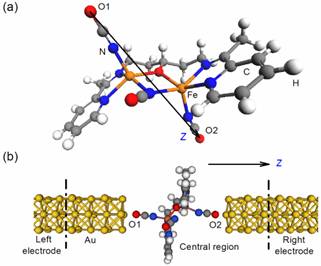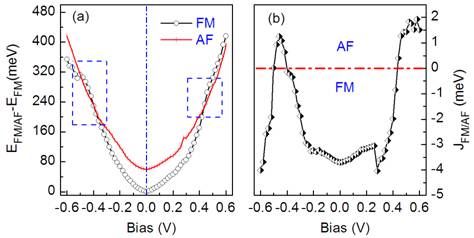Recently, Dr. Hao and Prof. Zeng in ISSP investigated the spin crossover (SCO) in a realistic molecular junction of the Fe2(acpypentO)(NCO)3 molecule sandwiched between two nanoelectrodes Au(100), their investigation indicates that the electrodes have essential impact on the SCO induced by an electric bias.
Manipulation of spin states by physical means is a hot issue in nanoscale materials. Researchers have found that such manipulation (or SCO) was obtained under external stimuli, such as a change of temperature, application of pressure, light irradiation and even magnetic field. However, it is preferable and a big challenge to achieve this manipulation only by an electric bias in real nano-devices. This electric SCO would be a great advance in molecular spintronics, and more importantly, provide a useful platform for magnetic molecule-based quantum computing.
[1] M. Diefenbach and K. S. Tim, Angew. Chem. Int. Ed. 46, 7640 (2007).
[2] N. Baadji, M. Piacenza, T. Tugsuz, F. D. Sala, G. Maruccio, and S. Sanvito, Nature Materials 8, 813 (2009).

Fig. 1. (a) The isolated Fe2(acpypentO)(NCO)3 molecule; (b) The molecular junction of the Fe2(acpypentO)(NCO)3 molecule.


Fig. 2. (a) Free energy of the molecular junction as a function of the applied electric bias. The square indicates the spin crossover. (b) The effective exchange constant as a function of the bias. (c) The spin crossover under an external bias denoted by a schematic graph.

Fig. 3. Mechanisms of the spin crossover in the molecular junction of a Fe2(acpypentO)(NCO)3 molecule.